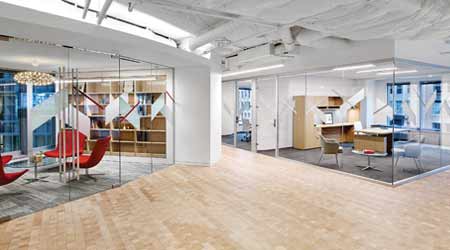 More modest executive space benefits from close proximity to supporting resources. At the American Insurance Association in Washington, D.C., the CEO’s glass enclosed window office is adjacent to a corner conference room and across from a library/meeting space. © Eric Laignel/courtesy of CallisonRTKL
More modest executive space benefits from close proximity to supporting resources. At the American Insurance Association in Washington, D.C., the CEO’s glass enclosed window office is adjacent to a corner conference room and across from a library/meeting space. © Eric Laignel/courtesy of CallisonRTKLOffice Interiors: Executive Offices Undergoing Changes
The C-suite - in the past often referred to as the "impenetrable fortress of leadership" - is being pared down to encourage collaboration and approachability.
Once upon a time, the CEO’s office seemed designed to intimidate, with large spaces isolated from the rest of the organization, windows on two walls, dark wood, and opulent wool rugs. That sort of space hasn’t vanished, but in many companies executive suites are becoming smaller, more functional, and more integrated into the floorplate. This trend, about 10 years in the making, aligns with the larger trend toward an open-office environment.
The palatial and well-appointed suite of rooms often seen in movies and television is being left behind, says Tom Polucci, director of interiors at HOK, along with the notion of “an impenetrable fortress of leadership.”
“Executives are seeing space they deploy as a key signature of their approach to company culture and how they want to be viewed,” says Eric Gannon, studio director and principal for Gensler in Chicago. “We are seeing executives trying to link themselves to their teams and be more accessible, and open office scenarios engaged teams better.”
Gannon says that when corner offices exist, they are less well-appointed, and enclosed spaces and private offices are “more modest in scale and finish.” In some instances, privacy can be created without enclosure, “by using program elements like buffers to create privacy and confidentiality without the full enclosure or the destination aspect of previous corporate environments.” Many executives feel comfortable being in the midst of the corporate environment, Gannon says, but “they need conference space or huddle rooms designated for them within close proximity.”
While the space dedicated to organizational leadership is shrinking, the degree of downsizing varies by organization, culture, and industry. Organizations can be found on both ends of the spectrum — from the CEO having his or her own office with dedicated meeting spaces to the top executive sitting in an open plan without a dedicated desk, says Deb Barnes, principal and office director at HGA. But change is evident across the industry. “We are seeing a trend toward an integrated executive team, with less emphasis on hierarchy and fewer requests for the large corner office,” she says.
The larger the organization, the more likely it is that there will be an executive suite or C-suite, Barnes says, but this is often driven by concerns about data integrity and security in general. Richard Bonnin, vice-president at HGA, notes that one large corporate headquarters in Minneapolis commissioned an open C-suite but then came back a few years later with security concerns. The space was changed by inserting a glass wall with an administrative assistant up front to serve as a gatekeeper.
In companies where the CEO has his or her own office, it will often be of modest size and not necessarily on the window line, which is dedicated to the open office environment shared by everyone in the organization, says Polucci. In other cases, C-suites may be “suited off and on the window line, but a bit smaller; assistants may have their own office in an adjacent space,” he says. The aesthetic is less opulent, reflecting quality and timelessness and “invoking a sense of authority and leadership,” Polucci says. The design might include a slight upgrade of quality and finish but doesn’t stand out as different or special from the rest of the space, “either in the traditional C-suite or when leadership is blending in.”
Related Topics:














